Martam Gaiyabari, Sombok, and Martam Daragaon in West Sikkim are composed of vast tracts of farmlands. The green paddy fields have gradually transformed into brown barren land with new modern structures overshadowing the old wooden houses. In 2022, I conducted a two-month fieldwork in the region. Martam Gaiyabari is also my ancestral village. ‘Participant observation’ an important method in my research, is embedded in our Nepali culture as ‘Sagaunu’ (helping). Guests, friends, families, and neighbors lend a helping hand. This is expected especially from women. I have focused on the ‘Fermented Alcoholic Beverages’ of the Limbu and Rai communities, ‘Fermented Soybean’ in a Limbu household, and ‘Fermented Leafy Vegetables’ in a Bahun household.
Archaeological evidence has revealed fermentation as one of the oldest food preservation methods.
Fermentation began with agriculture’s genesis when food was preserved for winters, droughts, and migration. ‘Ferment’ is derived from the Latin word ‘fervere’ (to boil). Scientifically, fermented food undergoes a controlled microbial process that enhances taste, texture, and aroma. There are two fermentation methods: wild fermentation like naturally fermented soybeans and culture-dependent fermentation where food is fermented by adding starter culture like ‘millet beer’. Fermentation is a part of food cultures across the globe, like Korea’s kimchi, the miso of Japan/Korea, Vietnam’s nem chua, and the idli of India/Sri Lanka. “In India, more than 250 types of fermented food (including beverages) are prepared and consumed” (Tamang et al., 2012). Gradually, fermented food became a part of modern healthy food practices believed to have nutritional benefits, as they contain probiotic microorganisms such as lactic acid bacteria. “Gundruk is taken to cure gastrointestinal problems and as an appetizer” (Tamang, 2009). Kikon (2021) describes how a community’s way of life is turned into lab-based experiments and marketability filled with health-conscious consumers. In Sikkim, Darjeeling, and Kalimpong, fermented alcoholic beverages are popular among the Bhutia, Lepcha, Limbu, and Rai communities. While the fermented saag/mula (leafy greens/radish) is a popular staple among most communities like the Newars, Chettris, Bahuns, Sunuwars, Rai, Limbu, Tamang, Bhujel, etc. Fermented food in Sikkim is connected to oral histories and myths, around which many rituals and festivals are performed. However, very little literature about its cultural and social significance for the communities is available.
“Culture can be explored through food”. (Stajcic, 2020) Food is an important facet of community gatherings, be it marriages, funerals, and childbirth. It shapes our ethnic, caste, and class identifications.
Ethnicity is the cultural characteristics that connect a group of people. Ethnic cuisine is a part of the heritage and culture of an ethnic group. “Food is a symbol of religion and plays an important role in tradition” (Sibal, 2018). For example, Muslims never consume pork and fast during Ramadan. Jains are usually vegetarians being followers of the non-violence doctrine. Fischler (1988) speaks of incorporation and self-identification saying, “We are what we eat”. Asian people are known for consuming rice. Similarly, Italians bring to mind the pasta. These food items may be found across the globe, but it is still linked to an ethnic group. In Sikkim, the Rais and Limbus do not consume mutton. This study’s participants responded by saying they believed “they will go mad” on consuming mutton. However, pork is an important food item, used in rituals, marriages, and festivals. Meanwhile, mutton is consumed by the Chettri-Bahuns, Newars, and other Sikkimese communities. It is a festival specialty prepared during Dashain.
“Food plays an important role in the social lives of diaspora” (Polat, S. A. & Polat, S., 2020).
Northeasterners who migrate to mainland cities like Delhi, Bangalore, Mumbai, etc. for jobs and education face taboos concerning their food, in particular fermented food. The movie ‘Axone’ directed by Nicholas Khargonkar explores this experience. Dirks & Hunter (2013) speaks of how food conveys memories. For example, I recall a small shop in Delhi’s Safdarjung (an area where many Northeastern people reside), that sold akhuni and fermented fish. We regularly visited the store with excitement. Food allowed us to remain connected to our home in a place where our culture was not acknowledged by the majority. Modern-day restaurants that serve ethnic food also bring people from the same community together. ‘Kalimpong Express’ a restaurant in Sarfdarjung serves the ‘Nepali thali’ (Nepali is a contested umbrella term used for the communities in Sikkim and Darjeeling). People from a similar Nepali ethnic background found solace in eating the ‘thali’. Similarly, my cousins in Western countries regularly meet and cook food items like gundruk or kinema.
Through the process of making fermented foods, I have tried to highlight its consumption alongside relationship with oral histories, rituals, and festivals.
This article aims to explore Sikkim’s ‘fermented food culture’ through the lens of the fermenter’s personal experiences. Furthermore, the fermentation processes differ not only among the communities but among households as well. The elements of taste, touch, and smell become essential in the process of making fermented food.
Fermented Millet Beer
Many scholars have explored the relationship between food, people, and faith. A similar link exists in the case of fermented alcoholic beverages among the Limbus, Rais, and Lepchas in Sikkim. The millets undergo a process of transformation via preservation. Sukhmani Limbu, a resident of Martam Gaiyabari prepared the ‘fermented millet beer’ for her son’s religious ritual called Phungshok Guru Puja, which would be held after fifteen days.
Fermenting millets is a laborious process, composed of the following steps:
Husking -->Grinding --> Boiling-->Drying--> Marcha addition--> Transferred and served in a bamboo flask





In a Limbu household, even the smell of ‘millet beer’ is revered. The consumption is linked with pregnancy, believed to be a gift from their goddess. It is used in festivals such as Chasok Tonmanga, a celebration of the first harvest. It is also consumed during wedding ceremonies where the Phendangba (priest) offers it to the goddess and in the Yandang Phongma (Naming Ceremony). Their Mundhum (Kirati oral history) speaks of the importance of millet beer concerning death. On the final day of the Sam Chaomma (death ritual), offerings such as rice, thi-tongba with pepsing (rice beer with bamboo straw), yams, wine, etc. are brought by the family members and placed on the altars made by the Phedangbas.

Similarly, the Rais use the ‘fermented millet’ during Sakewa and Sakela. It is first offered to the kitchen’s main pillar, the cooking fireplace, and then to their goddess. According to their Mundhum, it is similarly linked with pregnancy. They believe the goddess Sumnima gave the millet grains as a gift for women. During marriages, the guests are served ‘millet beer’, and the bride and the groom drink ‘millet beer’ from the same wabuk/chindo (gourd flask). The inside of the Wabuk/Chindo is bitter, it is believed that the bitterness combined with the millet beer (jaad) neutralises poisonous substances.

An extract from the Rai Mundhum on ‘Millet Beer’:
“Who made this beer?
Who prepared it?
Who owns it?
Who is it for to drink?”
(Source: International Kirat Rai Linguistic and Cultural Research Centre, Sikkim)
Among the Lepchas, Chi (Millet Beer) is associated with God and nature worship. “Thong yuh gunmon, thong muhyun gunnyong” (if one drinks the beverage within limits, it serves as medicine otherwise it is poison) is a famous Lepcha saying. Pem Dorjee, a Lepcha resident from West Sikkim, added that ‘millet beer’ is used during the Tong rum faat (birth rituals) and the Sunglyong (death ceremonies). It is also used in marriages by the Bongthings (priests). During ancestor worship, the ‘millet beer’ is kept in a sung kyo (wooden pot) along with five types of ghee and a stick as an offering. Tsering Lepcha, a 60-year-old resident from West Sikkim, mentioned that the person making the fermented beer is a woman above the age of fifteen, who is prohibited from consuming salt, oil, or anything sour. She further mentioned that it is an age-old tradition to serve honoured guests ‘millet beer’. According to the respondents, these fermented alcoholic drinks were made to preserve food during titha (famine).
Raksi (An Alcoholic Beverage)
Raksi is a traditional distilled drink, with a high alcohol concentration. It is made up of corn, simal tarul (a type of yam), etc. Limbus use a special raksi-making dish called Yagambha for the process of distillation. Mandal (2013) mentions in Nepal the state clubbed indigenous groups under the term ‘matwalis’ meaning alcohol drinkers. It was contested by many as a derogatory term given by the upper-caste Hindus. The entire process of distillation takes about six to seven hours and requires a lot of firewood. The raksi has to be offered to God before consumption.


Marcha (A Starter Culture)
Marcha is a very important starter culture, especially among the Rais and the Limbus. It is used in Sikkim, Darjeeling, Kalimpong, Nepal, Bhutan, and Tibet (China). Phepani Limbu, a marcha maker from Martam Gaiyabari asserts “The world cannot move without this”. She depends solely on the marcha for her income, which is sold in nearby areas and sometimes sent to Delhi. Among the Limbus, the marcha-making process is passed down from the mother to the daughter. Women are forbidden from consuming sour food three days before the making of the marcha.
A pre-requisite of the marcha-making process is the collection of fern leaves, locally known as Phiraunay (Buddle Asiatica). Usually, a man goes to the forest to collect the ferns and some special roots. The leaves are selected for their freshness.
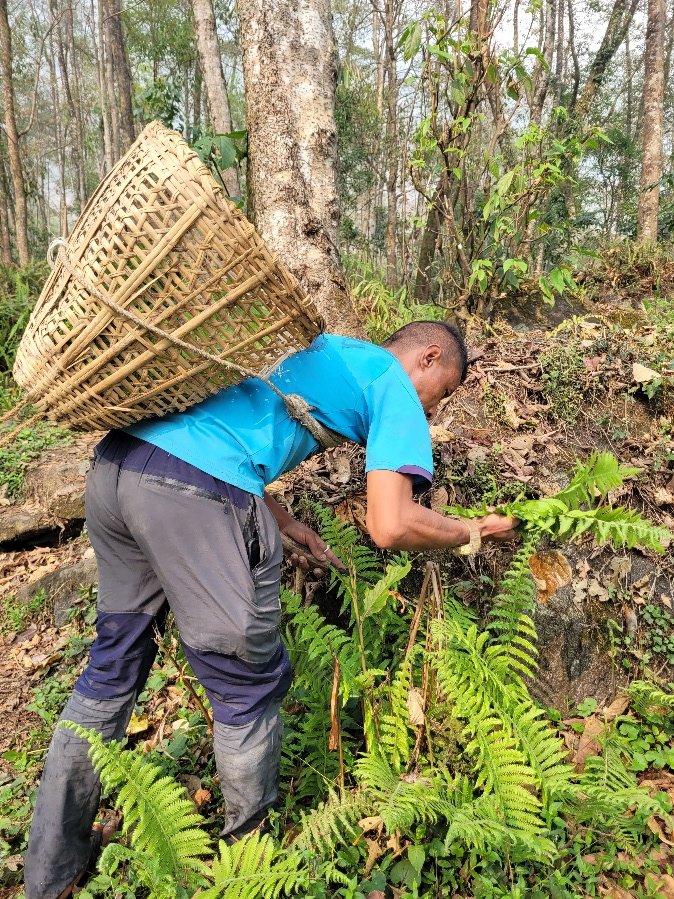
Photo: Ayushi Nirola
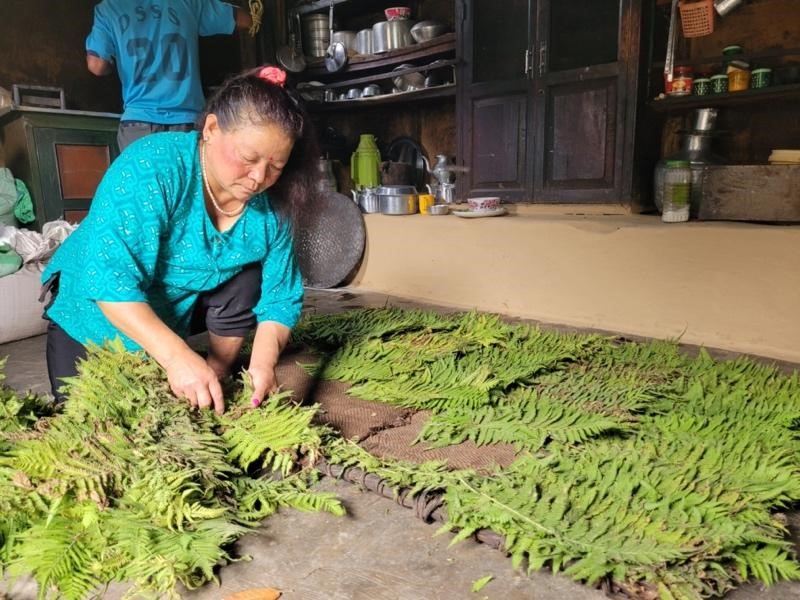
Photo: Ayushi Nirola
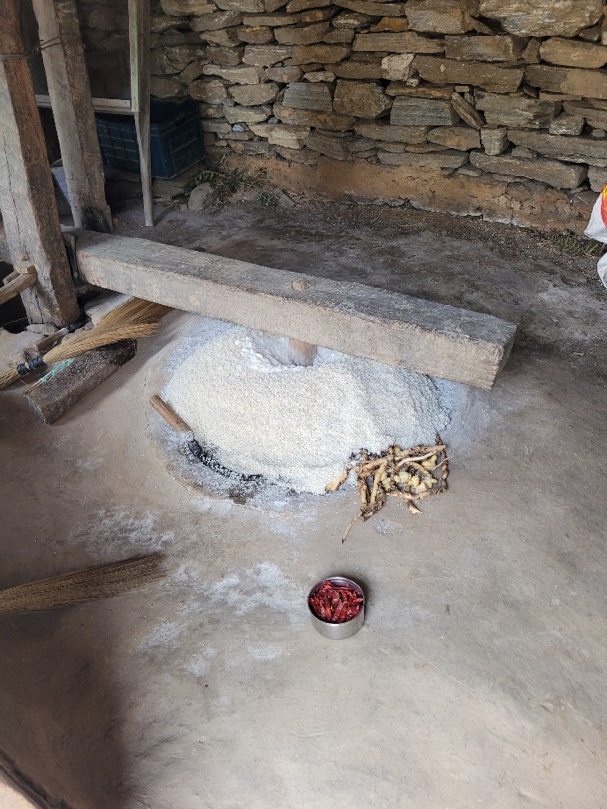
Rice is ground in the deki and mixed with special roots, red chilli, and ginger/
Photo: Ayushi Nirola
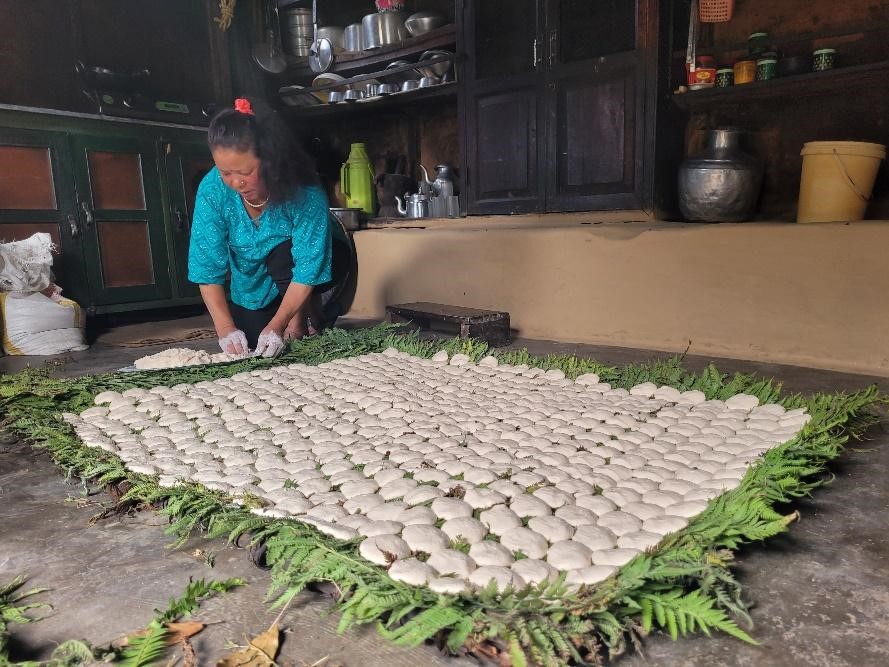
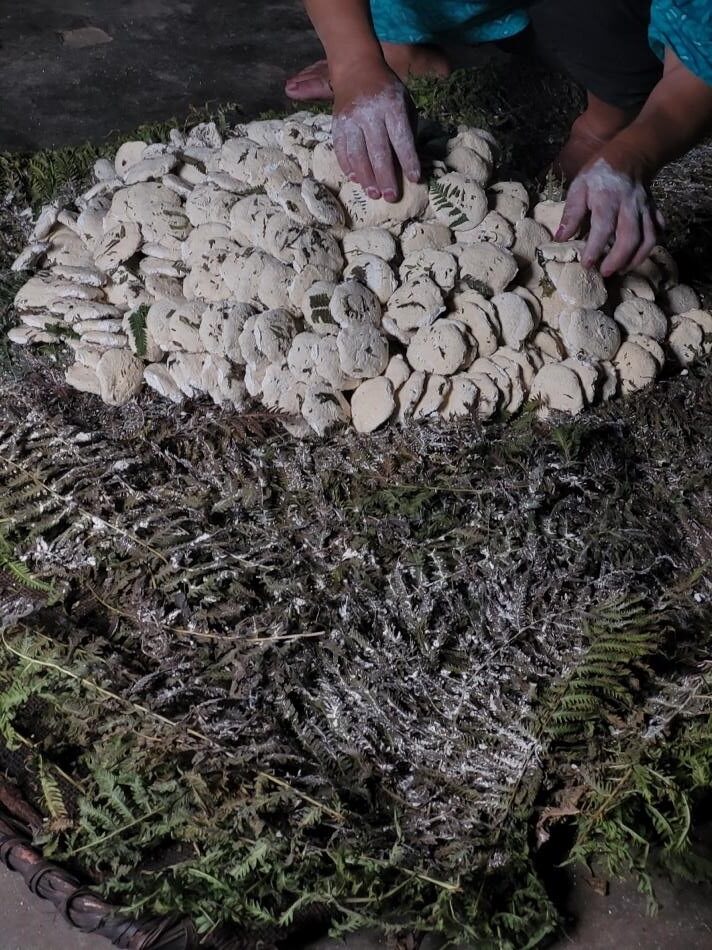
According to the Rai Mundhum, the marcha was a gift from Naimma-chinima (female deities).
“Long ago! Naimma-Chinima appeared
On the gourd-sprout
It is Naimma-Chinima
They produced yeast
That led to brewing the beer”
(Source: International Kirat Rai Linguistic and Cultural Research Centre, Sikkim)
Kinema (Fermented Soybeans)
Kinema,similar to Nagaland’s axone is another popular fermented product. It is consumed mostly by the Limbu, Rai, and Tamang communities in Sikkim, Darjeeling, and Kalimpong. The two Limbu fermenters from West Sikkim followed different processes to ferment soybeans. “It is called Chembig in the Limbu language; fermented soybean is ingrained in Limbu food culture. It was practiced by our ancestors and passed to the new generations as an essential way of preserving food. The Chettri-Bahun community in the rural areas don’t consume it, while in the urban areas whoever likes it consumes it”, shared Phepani Limbu. The upper-caste Hindu families in Sikkim’s rural areas generally consider Kinema smelly (impure) and do not consume it. In my ancestral village, my upper-caste relatives do not consume it while my family in an urban setting does. Douglas (1966) talks about how certain foods could be seen as pure or dangerous within religious frameworks. The hegemonic Brahmanical idea of what is pure or impure continues to persist in India. While in the larger picture, fermented food may bring Northeast Indians together, we cannot ignore how within Sikkim different communities perceive fermented food differently. Food divides and brings people together.
Many Asian communities uphold this tradition of fermenting soybeans to develop a sticky texture that is quite flavourful. According to the Mundhum (Kirati oral history),the black soybean was the first crop cultivated by them in Sikkim. Their daily diet turned flavourful with the introduction of the soybean.
Steps involved in making Kinema:
Soybeans are washed -->Boiled-->Placed in a basket and covered with leaves-->Stored in a warm room (3 days)-->Ready for consumption
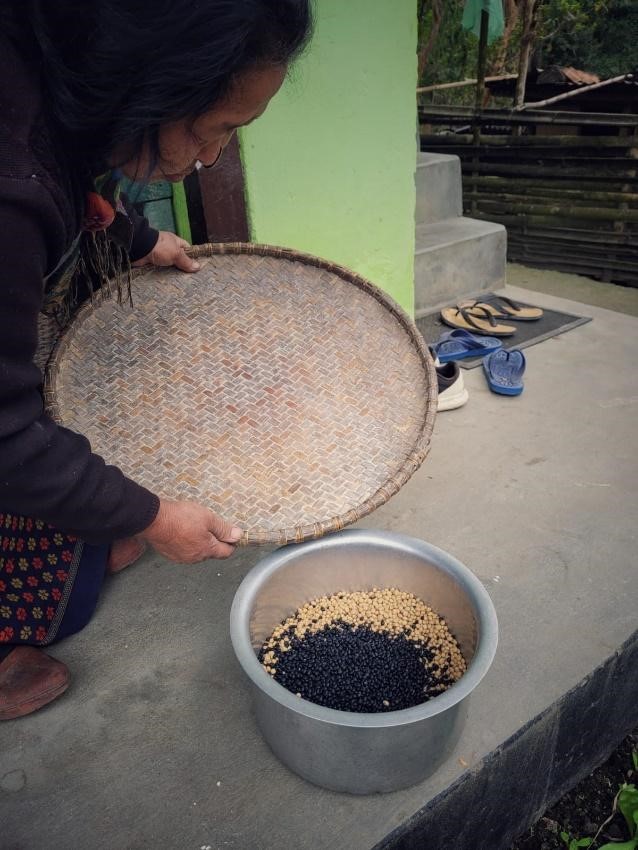
Soybeans are firstly husked /
Photo: Ayushi Nirola
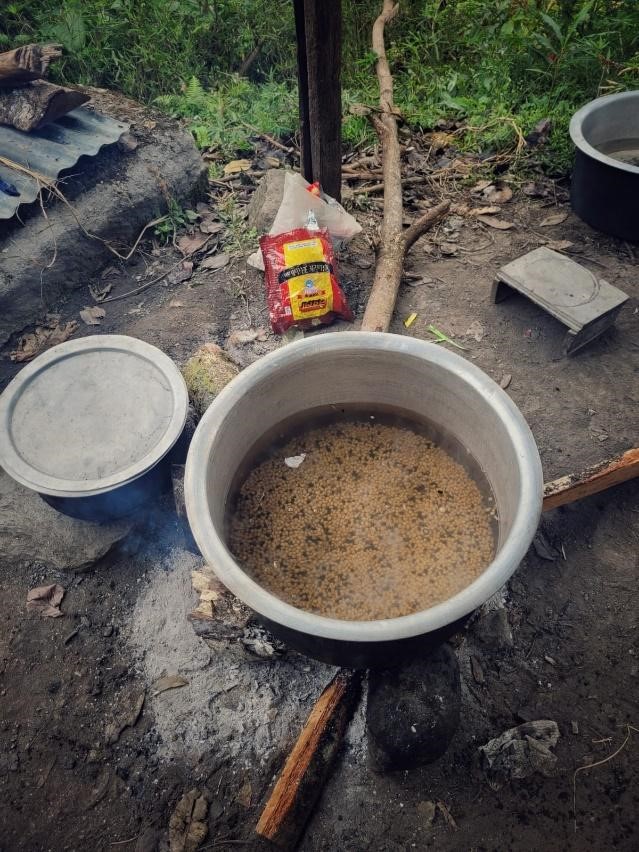
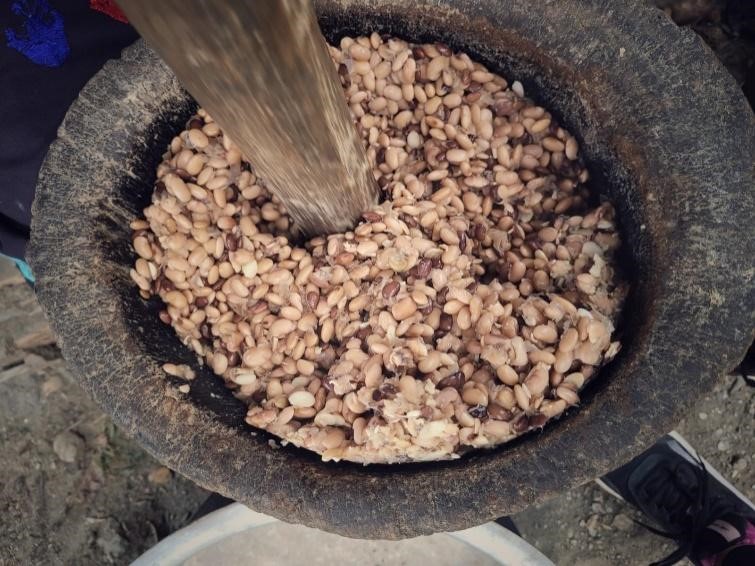
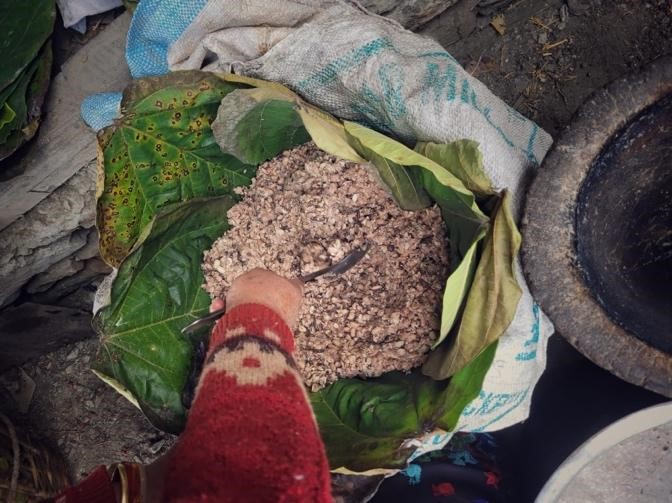
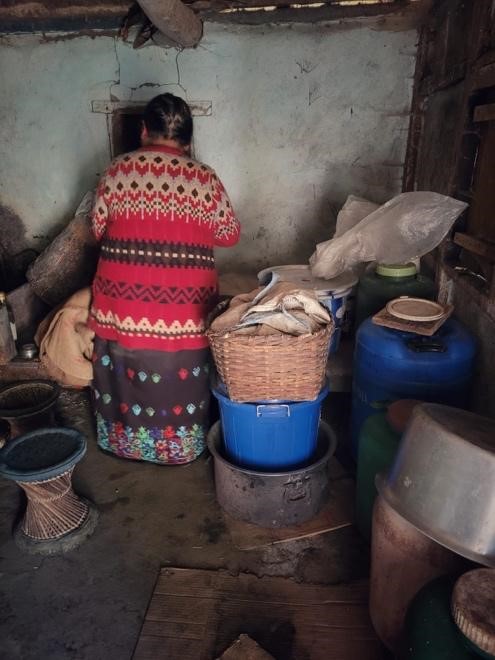
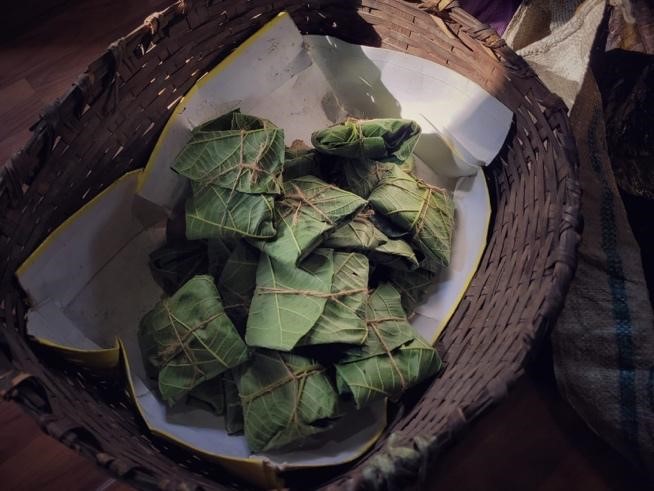
Sinki (Fermented Radish)
The process of fermenting radishes (sinki) takes three days with a waiting period of one month. A hole is dug for storage where the dried radishes are placed for about 22 to 31 days. “It has a pungent yet homely aroma”, shared one of the fermenters. It is believed during an attack by Prithvi Narayan Shah, Kritipur’s Newars hid themselves and buried their harvest consisting of rayo ko saag (green leafy vegetables), mustard leaves, and radish. After the war, they took out the buried food which had turned into fermented gundruk and sinki (Tamang & Kailasapathy, 2010).
Steps involved in making Sinki (For 85kgs of radish)
Seeds are sown (July-August) -->Sourced from the field (December- January)--> Dried under the sun (1-3days) --> Leaves are separated from the main body of the radish (2 hours) -->The radishes are washed (3-4 hours)-->Cut into pieces (A Day)-->Pieces are dried under the sun (A Day) -->A pit is readied, and preheated with fire (1 hour)-->The pieces are put in a bag and placed in the pit (35 minutes)-->Left for fermentation (One month)-->Taken out and dried under the sun-->Packed in a bottle (for two years or more) and consumed as soup /pickle

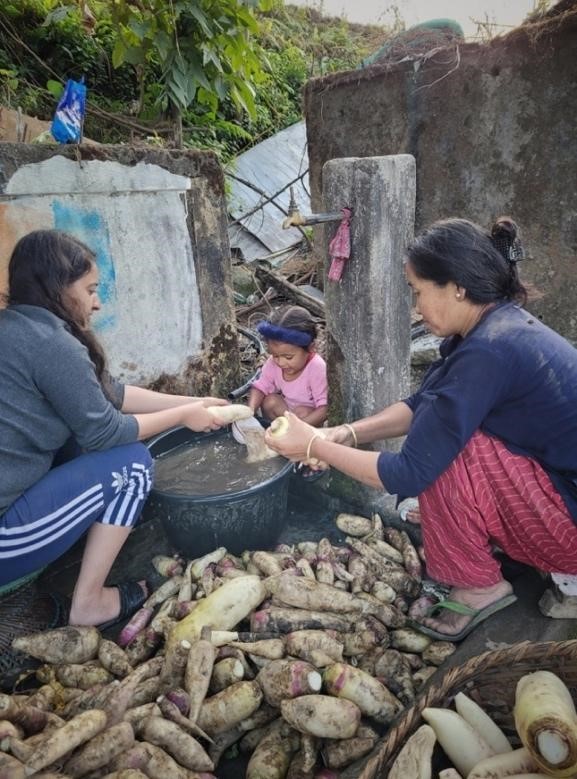
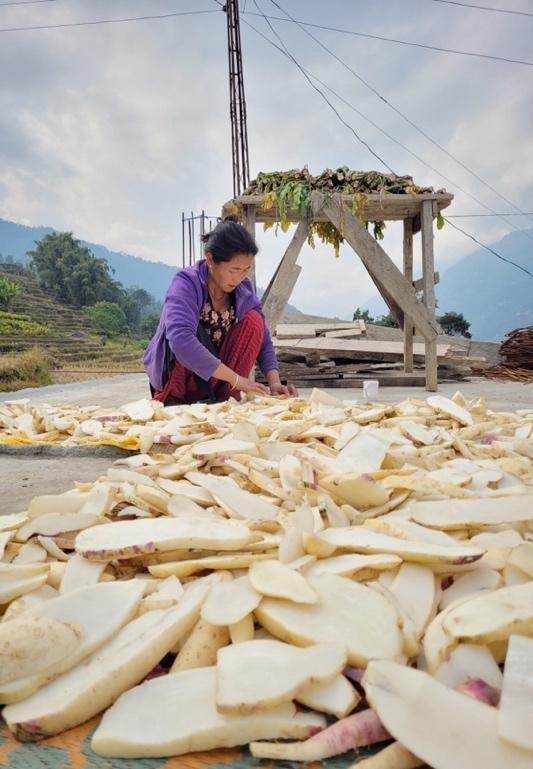
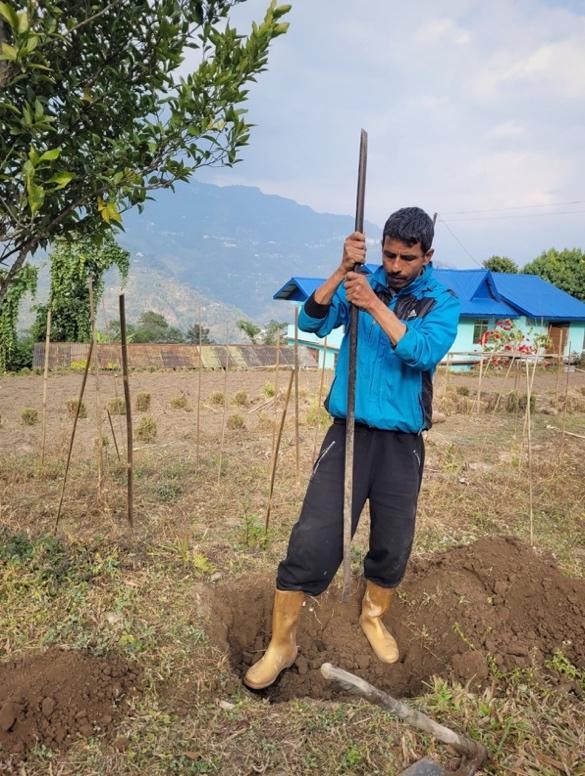
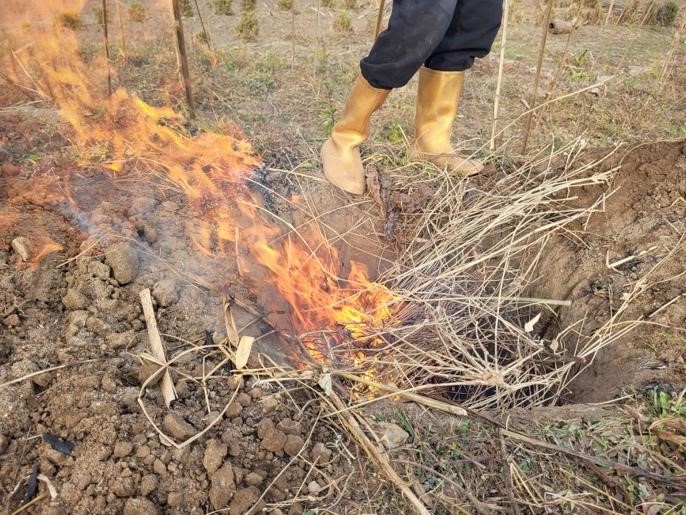
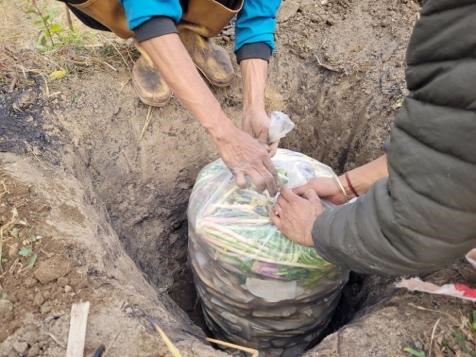
Photo: Ayushi Nirola
Many other fermented foods are consumed in Sikkim, Darjeeling Himalayas, and Nepal. For instance, fermented dairy products like curd, ghee, mohi, and chhurpi (soft and hard cheese).

Selroti, a ring-shaped food made from fermented rice is used across festivals like Dashain, Tihar, Bhai Tika, Maghey Sankranti, Kul Pooja, etc. In Sikkim, ‘Dashain ko baagh’ (basket of Selroti and sweets) is gifted to neighbors (Bhutias, Tibetans, or Lepchas). In return, they give their Nepali neighbors Kyapse (Tibetan biscuit) during the Losar festival. This is a special way of bonding among the diverse communities.
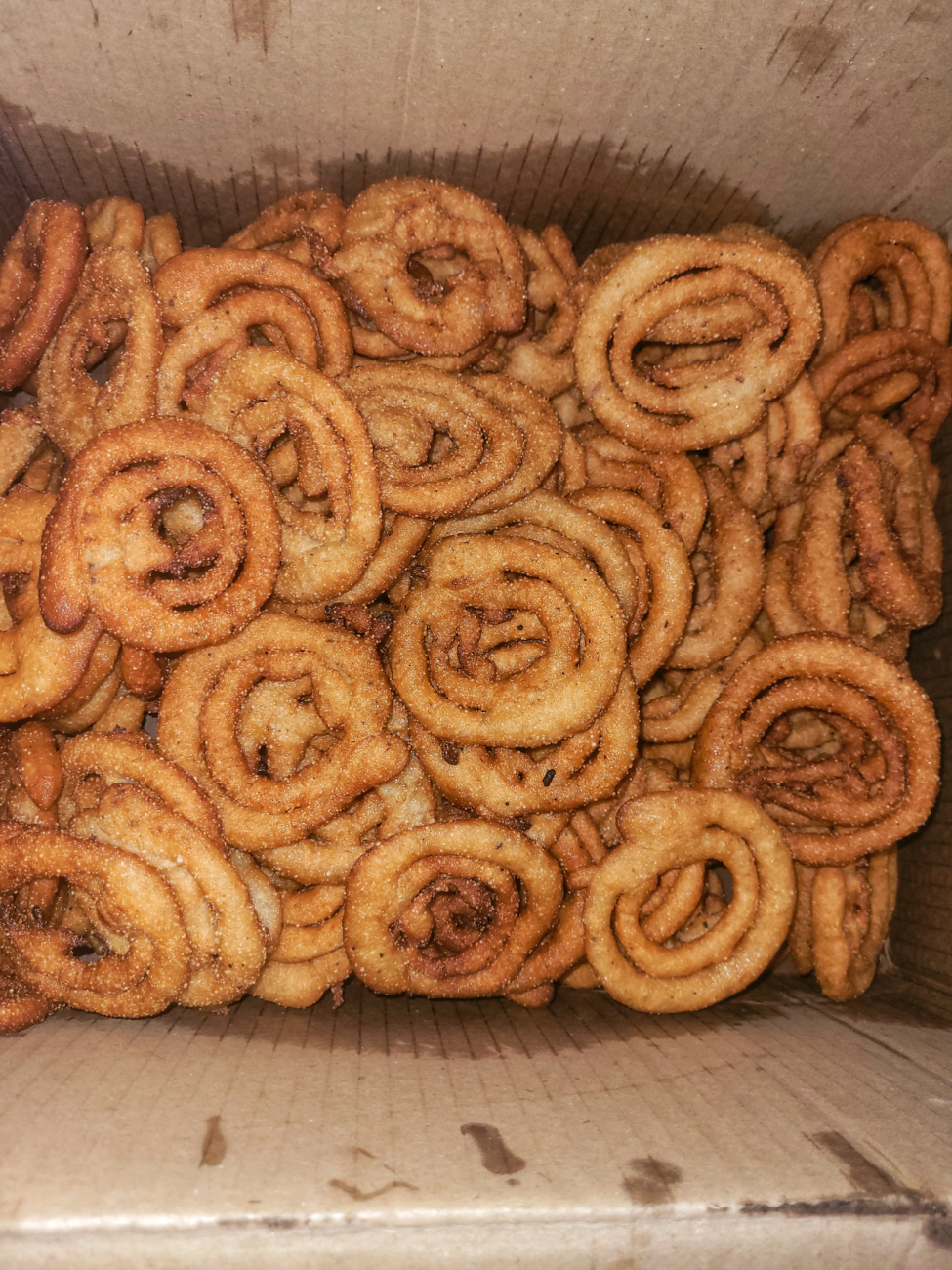
Bamboo, known by many names across communities: tama (Nepali), khorisa (Assamese), and lung seij (Khasi) is a local delicacy. Young edible shoots are fermented into what Limbus call ‘mesu’ (‘me’ means young bamboo shoots while ‘su’ means sour). Bamboo shoots and Dalley (Eastern Himalayan Chilli) are a common combination, fermented in glass bottles.
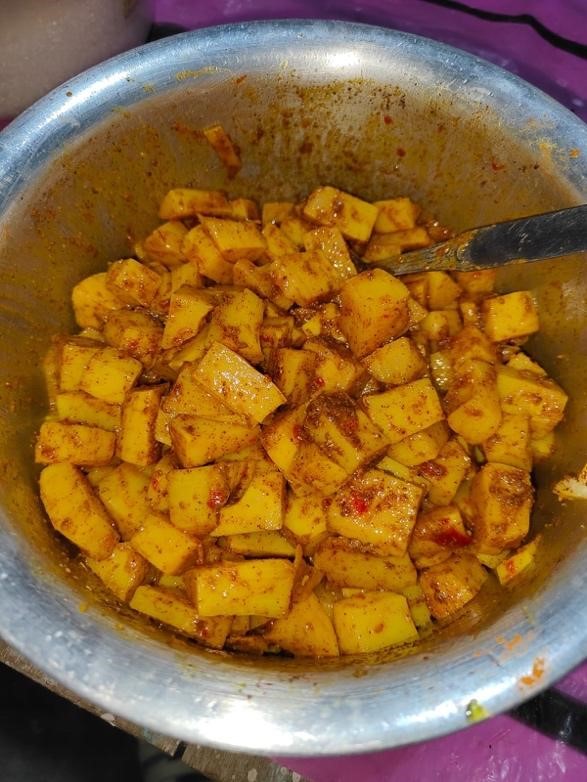
Photo: Ayushi Nirola
Khalpi (cucumber pickle), sun-dried/smoke-dried meat, and sun-dried fish (sukuti and sidra) are other fermented food items that are consumed.

Food is an inherent part of the social identity of communities.
“It shapes everyday engagement, imagination, and projects of modernity” (Kikon, 2018). The importance is reflected in their oral traditions and beliefs, with certain foods being associated with particular festivals or ceremonies. Furthermore, when people travel far from home, they carry fermented food like the kinema, chhurpi, gundruk, selroti etc. As fermented food undergoes transformation and preservation, it also transforms our idea of identity and belonging.
References
- Tamang, et al. (2012, January). Microorganisms and Nutritional Value of Ethnic fermented foods and Alcoholic beverages of North East India. NIScPR
- Tamang, J.P (2009). Himalayan Fermented Foods: Microbiology, Nutrition and Ethnic Values. CRC Press.
- Kikon, D. (2021). Bamboo Shoot in our Blood. University of Chicago Journals.
- Stajcic, N. (2020). Food as A Means of Communication.
- Sibal, V. (2018). Food: Identity of Culture and Religion.
- Fischler, C. (1988). Food, Self, and Identity.
- Polat, S. A. & Polat, S. (2020, July). A Theoretical Analysis of Food Meaning in Anthropology and Sociology. Research Gate.
- Dirks, R. & Hunter, G.(2013). Routledge International Handbook of Food Studies.
- Mandal, M. (2013). Social Inclusion of Ethnic Communities in Contemporary Nepal.
- Douglas, M. (1966). Purity and Danger: An Analysis of Concepts of Pollution and Taboo.
- Tamang & Kailasapathy. (2010). Fermented Foods and Beverages of the World. Taylor & Francis Group.
- Kikon, D. (2018). Eating Akhuni in India. Cambridge University Press.
Ayushi is a PhD scholar of Anthropology at Sikkim University. She holds an M.A. in Advertising and Public Relations from Sri Aurobindo College for Arts and Communication, New Delhi, and an M.A. in Anthropology from Sikkim University. Her research interests are food, migration, urban anthropology, and visual anthropology. She has participated in many projects like the documentary collaboration project between the Indigenous Team of Sikkim University and the University of Lapland, Finland. She was a recipient of the Zubaan Sasakawa Peace Foundation Grant and worked on women health workers during the COVID-19 pandemic. She was also part of the Sikkim University project "Declining Anganwadi Beneficiaries" by the Sikkim Women and Development Department alongside the Sociology Department.
I gratefully acknowledge Sukhmani Subba, Phepani Subba, Gyan Prasad Nirola, and all the participants without whose support the process of learning about fermentation would not have been possible. I am also very thankful to my supervisor Dr. Garima Thakuria for her support. Special thanks to Shaykar Sharma, Sandeep Sharma, Santa Biswakarma, and Bhim Sharma for their valuable support during this project. Lastly, I am thankful to Bibhusha Rai, and the Project Sikkim team as without their support this article would not have been possible.
7 comments on “THE FERMENTED FOOD CULTURE OF SIKKIM”
Leave a Reply
Latest Posts
Latest Comments
No 'Comments_Widget_Plus_Widget' widget registered in this installation.


I am actually grateful to the owner of this site who has shared this
wonderful paragraph at here.
Such detailed and insightful study on the fermented food culture of Sikkim practiced among the different community of Sikkim.
Loved it going through.
Thank you so much for your lovely words
Dear Arushi
Great to learn from this article and I came across first of this kind of project published in the field of ethnic fermented food culture of Sikkim.
I liked the project.Let this project help our people to understand better to preserve our ethnic practices.
Best wishes for your future endeavour Arushi .
I am so glad you liked it, uncle. Thankyou for your kind words.
I had the pleasure of reviewing the research conducted by Miss Ayushi in the field of ethnic food, and I am thoroughly impressed. Her work reflects a deep understanding of diverse culinary traditions, showcasing a commitment to preserving and celebrating cultural richness. The attention to detail, innovative approach, and dedication to exploring the nuances of ethnic cuisines had made the research both insightful and impactful.
Thankyou for reading and reflecting on it. I hope it adds to the literature. To more learnings and unlearning,di 🙂